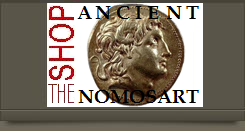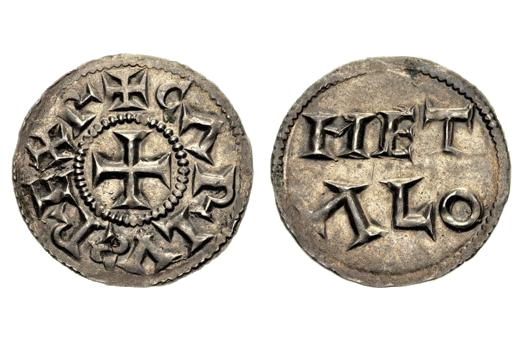
about ancient nomos
Ancient Nomos Art is a museum of galleries exhibiting ancient coins and ancient mint maps. The coin gallery displays the diverse art and history of hand-crafted ancient Greek, Roman, Byzantine, Persian and Medieval coinage. The ancient mints mapping gallery features Greek, Roman, Byzantine, Asia Minor and Medieval mint city regions and territories. Visitor's are welcome to explore, study and enjoy Ancient Nomos Art.

Medieval, France – 922 AD
Charles le Simple
From Ancient Galleries

Obverse: Legend + CΛRLV S REX R around centered cross pattée in beaded border.
Reverse: Legend MET ΛLO abbreviation for Metallum mint, engraved in two lines.
LEGEND
Obv: Centered Cross Pattée with serifs; Latin legend, + CΛRLV(retrograde S) REX R (sic), all within two beaded borders. Rev: Latin legend, MET/ΛLO, the abbreviated Metallum mint name in two lines.
King Charles III “le Simple” (Latin meaning; Carolus Simplex), was medieval King of a region known as West Francia. He was the son of Louis II (known as “the Stammerer” king), and was a member of the powerful Carolingian dynasty. Some scholars suggest the name Charles “le Simplex” has been misinterpreted to mean a simple man. Contrary, most believe he was neither a “simple” king nor a “stupid” king. The names more accurate definition in Latin means one who is “loyal” or one who is without “guile” attributes. Charles III was unofficially crowned king by a group of loyal Francia noblemen in 893. He was officially crowned sole king of Francia in 898. He is celebrated for the famous Treaty of Saint-Clair-sur-Epte, declaring peace with the Normans in 911. The treaty granted as fief a portion of northern France, known today as Normandy, to the Norse pirate and leader Rollo. As a condition to fiefdom, Rollo promised to become Christian, protected and help defend the territory from future attacks. The spectacular silver denier specimen was issued by King Charles III in 898 AD. The coin features a central cross pattée image with serifs to symbolize the medieval passion and belief in Christianity. The Latin engraved legend surrounding the cross reads; +CΛRLVS REX R, which refers to the king’s abbreviated name. The legend is encircled by two beaded borders and surrounds the cross. The coin reverse legend is the abbreviated name, using two lines, for where the coin was produced or the coins mint location. The first line MET and second line ALO indicates the abbreviation for the famous mint of Metallum (Melle), the wealthy medieval city of West Francia. Again, the legend is all within an encircled beaded border. The medieval Carolingian reverse mint abbreviation legends, using the two line type Latin abbreviations, began being issued in by Francia mints in 818 (see Louis I denier). The city of Metallum was a thriving medieval location and is known for having one of the largest silver mines in the Carolingian empire. In his later years, Charles III territory grew eastward and expanded into the region of Lotharingia from 911 until 919 AD. However, progress for Charles III was stopped in 923 AD when he was defeated and later imprisoned at the Battle of Soissons, ending his 25 year reign. Charles III died on 7 October 929 AD.
DOCUMENTATION
Value: Denier. Metal: AR Silver. Weight: 1.58 grams. Mint: Metallum (Melle, Aquitaine). Date: circa 898-922 AD.
Attribution: Depeyrot 629; M&G –; MEC –; Fécamp 8388-8400. Photo courtesy CNG.
Legend, Documentation and Attribution
